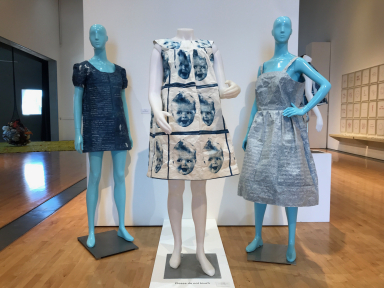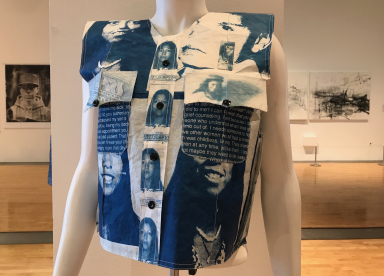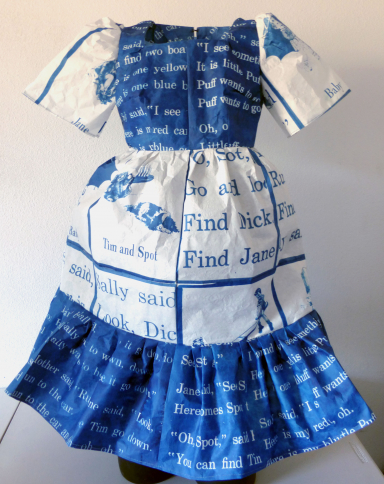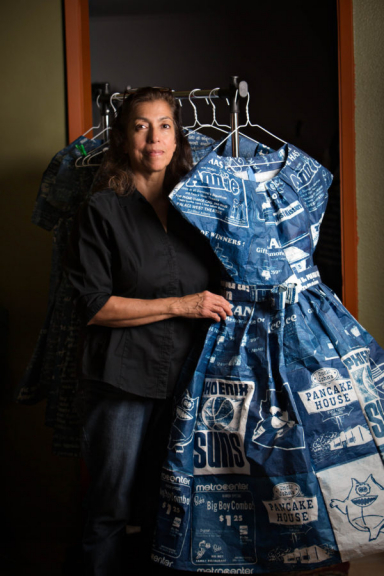Annie Lopez | by Ben Rains
August 20, 2018

Annie Lopez: Cyanotype Artist
While researching artists who are currently working with the cyanotype process, I stumbled upon Phoenix, Arizona based Annie Lopez’s series of dresses. Her work was featured in the 2016 exhibition ‘Cyanotypes: Photography’s Blue Period’ at the Worcester Art Museum. Her garments immediately captured my attention and imagination, and drew me in to learn more about their creator. The dresses – patterned, printed on cyanotype sensitized tamale wrappers, and sewn by Lopez – offer a perfect example of how cyanotypes can be used in ways uncommon to other photographic methods. The flexibility of the process has allowed her to create something that’s engaging, and which also defies easy categorization.
At heart Lopez is a storyteller. As art objects, the dresses have refreshing familiarity and a personal nature to them. Each piece offers a vignette of some aspect of Lopez’s life, and often address the challenges of being a Latina woman in the United States. She’s a benevolent and gifted raconteur though, and softens the more pointed edges of her messages with the inherent playfulness of her art and with her humor, but without compromising their meaning. The results are works, or stories, which evoke a sense of empathy in the viewer.
The art’s message is honest, and sometimes painfully so. The frankness of it allow us to get to know the artist better by offering a kind of dialogue one might have with a close friend over coffee. The dress featured in the Worcester exhibition, “Medical Conditions”, deals with caring for an ailing parent and the frailty of memory in a father suffering from Alzheimer’s. A more recent dress pays tribute to her friend and fellow artist, Steve Gompf, who recently passed away. Others reflect the memories of childhood, the struggles of reconciling the complicated facets of one’s cultural identities, and the absurdity of stereotypes. While the stories of Lopez’s dresses are unique to her, in that they’re drawn from her own life, they are at the same time universal to the human experience, and are powerful because of Lopez’s skill in making them relatable.
That directness and accessibility of Lopez’s artwork runs deeper than just the stories and how she tells them. It’s also reflected in the very nature of the photographic process she’s chosen to create with: the cyanotype. An important feature of the process is its incredible versatility for making just about any paper or natural fabric photosensitive. This opens up the capacity to incorporate photographic imagery into all sorts materials, and it’s because of this that Lopez was able to craft her dresses made from cyanotype sensitized tamale wrapping papers.
- Ben Rains
For more information on the artist and her work, visit Annie Lopez’s website and social media pages:AnnieLopezArtist.com | Facebook | Instagram
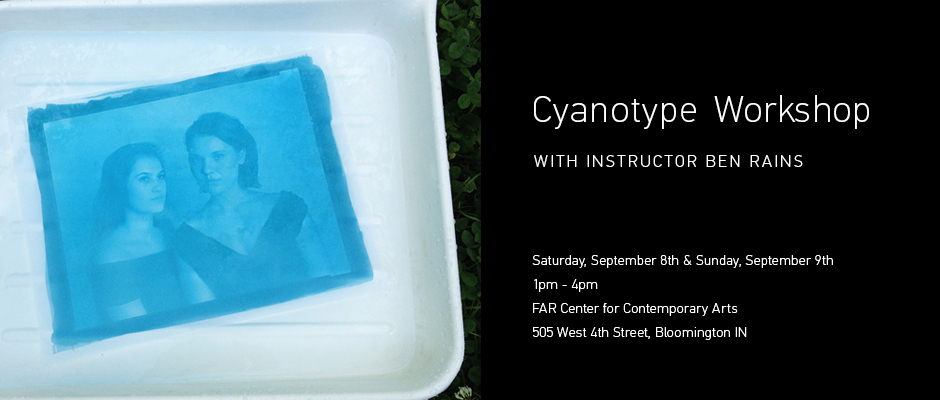
The cyanotype is nearly as old as the invention of photography itself, created by Sir John Herschel only a few short years after Louis Daguerre’s introduced the daguerreotype and Talbot’s his salt prints and calotypes, which are complicated and involve many steps. In contrast to those early forms of photography, the cyanotype’s most notable attribute, after its distinctive blue color, is the simplicity of the process. Practically since its invention, cyanotype was promoted as an ideal process for amateurs and novices, but it has also been used throughout its history by professional artists.
Pictura Gallery at the FAR Center for Contemporary Arts will be hosting a two day intensive workshop on the cyanotype process taught by Ben Rains from September 8th-9th. You’ll learn about the history and artists using the cyanotype, receive a weekend of instruction with lots of hands on experience working with the process, and all the information you’ll need to continue making cyanotypes on your own
Workshop Registration
